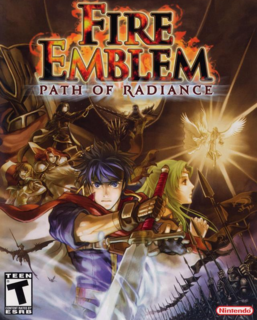Underneath the less than stellar presentation, is a game that pulls off is a complex, tactical, and worthwhile adventur
The story of Path of Radiance follows a young fighter named Ike, whose father is the commander of a group of "sell-swords". The Greil Mercenaries (as they're called) defend daily the rural areas in their home country, Crimea, from various groups of bandits and pirates. All of this changes, however, when the neighboring country of Daein destroys Crimea's capital and Ike finds himself commanding the group sooner then he had imagined. Regardless of the familiarity of the storyline's set-up, remember that this is Fire Emblem, and like other FE entries, it expands upon the basic premises of an RPG with a richly crafted story that contains some surprising depth to its large cast of characters (even the minor ones get plenty of spotlight).
Path of Radiance is a chess-like, turn-based strategy game. While most of the missions typically involve "annihilating the enemy", what makes the game so rewarding is the tactical depth involved in completing your objectives. During the game the player must understand which weapons are strongest and weakest against others, distribute or store bonus experience points wisely or decide best how to utilize your shape-shifting flesh-ripping animal-human hybrid characters to the best of your advantage.
Even though much of the game follows more traditional RPG elements, one of the most notable features is also one of its most controversial. During a battle, if one of your characters dies, they are gone for good. This feature makes characters feel more valuable and less like expendable conscripts. Furthermore, you can either accept the loss as a necessary means to an end, or restart the entire chapter to keep the character - which can make the game seem more open-ended but can also frustrate the player into smashing the GameCube over a nearby family member's head..
Despite the fact that Path of Radiance follows the same gameplay structure as previous installments, there's a nice assortment of interesting tweaks. Most notable is what you can do in-between battles to manage your army with the new home base feature. Utilizing this feature, you don't have to have support conversations during the battles themselves, which is more logical considering the length of some of the conversations. Also present are shops for usual buying, selling and even creating your own customized weaponry. Finally, you can award experience points to characters in your party, even if they have not earned them fighting battles in the game. Is this cool, or does it feel like cheating?
A few nuances have been added to the already strong gameplay. The most noticeable is an entirely new race of humans, called the Laguz. They are tribe of people who have the ability to change into fierce tiger-like creatures, gigantic hawks, and mythical dragons. The twist, however, is that they can't stay powered-up creatures forever and while they are in human form, they are unarmed and can't attack. Most Fire Emblem players will find the new race a refreshing break, while some fans my feel a little indifferent and continue to use regular human characters. Nevertheless, this adds a fun new level to the strategy. Other less obvious features include the ability to "shove" an ally or enemy over a space, and while this feature is not vastly used while playing, it is a nice option.
The game's only one true glaring flaw is found in the graphics and animation department. While they aren't "Tales of Symphonia overworld-ugly", they leave something to be desired. On the animation side of things, when units exchange blows it's rather drawn-out and sometimes dull, but fortunately the battle sequence can be turned off to quicken the pace. In contrast to the less-impressive visuals, the hand-drawn artwork for each character is great and really represents his or her personality. Also, during key parts in the story, special fully-animated scenes that look like cel-shaded Japanese anime occur. Suffice it to say, they are stunning to watch, although the voice work during these sequences is something to be desired. Luckily, the rest of the sound is superb with weapons and spells sounding as powerful as ever in Dolby 5.1 - but the music itself is the real show stealer here. It may not all be orchestral, but it's very well-composed and adds to the drama and action of the game.
Underneath the less than stellar presentation, is a game that pulls off is a complex, tactical, and worthwhile adventure. It achieves what a lot of RPGs set out to do, but in the end, utterly fail to accomplish. It may not win over many new fans, but those who enjoy Fire Emblem will continue to love it.

